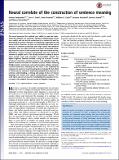Neural correlate of the construction of sentence meaning
Author(s)
Scott, Terri L.; Brunner, Peter; Coon, William G.; Schalk, Gerwin; Fedorenko, Evelina G; Pritchett, Brianna L; Kanwisher, Nancy; ... Show more Show less
DownloadFedorenko-2016-Neural correlate of the constru.pdf (1.045Mb)
PUBLISHER_POLICY
Publisher Policy
Article is made available in accordance with the publisher's policy and may be subject to US copyright law. Please refer to the publisher's site for terms of use.
Terms of use
Metadata
Show full item recordAbstract
The neural processes that underlie your ability to read and understand this sentence are unknown. Sentence comprehension occurs very rapidly, and can only be understood at a mechanistic level by discovering the precise sequence of underlying computational and neural events. However, we have no continuous and online neural measure of sentence processing with high spatial and temporal resolution. Here we report just such a measure: intracranial recordings from the surface of the human brain show that neural activity, indexed by γ-power, increases monotonically over the course of a sentence as people read it. This steady increase in activity is absent when people read and remember nonword-lists, despite the higher cognitive demand entailed, ruling out accounts in terms of generic attention, working memory, and cognitive load. Response increases are lower for sentence structure without meaning (“Jabberwocky” sentences) and word meaning without sentence structure (word-lists), showing that this effect is not explained by responses to syntax or word meaning alone. Instead, the full effect is found only for sentences, implicating compositional processes of sentence understanding, a striking and unique feature of human language not shared with animal communication systems. This work opens up new avenues for investigating the sequence of neural events that underlie the construction of linguistic meaning.
Date issued
2016-09Department
Massachusetts Institute of Technology. Department of Brain and Cognitive Sciences; McGovern Institute for Brain Research at MITJournal
Proceedings of the National Academy of Sciences
Publisher
National Academy of Sciences (U.S.)
Citation
Fedorenko, Evelina; Scott, Terri L.; Brunner, Peter; Coon, William G.; Pritchett, Brianna; Schalk, Gerwin and Kanwisher, Nancy. “Neural Correlate of the Construction of Sentence Meaning.” Proceedings of the National Academy of Sciences 113, no. 41 (September 2016): E6256–E6262. © 2016 National Academy of Sciences
Version: Final published version
ISSN
0027-8424
1091-6490